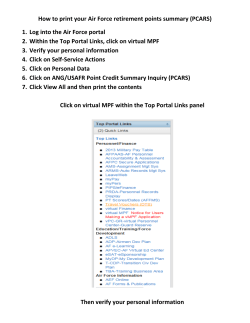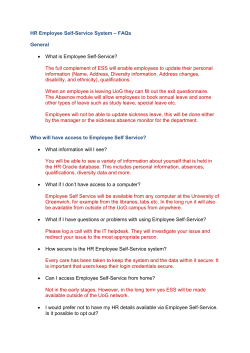
Viewing - BMC Communities
White Paper Remedyforce Professional Services Leveraging BMC Remedyforce Self-Service Kelley Mitchum 27 February 2015 Remedyforce Professional Services Leveraging BMC Remedyforce Self-Service Welcome to the “Getting Started with BMC Remedyforce” Series Today’s IT departments must drive business growth and innovation, while coping with less resources and increasing complexity. To do this, they require an IT Service Management solution that provides best practices while minimizing costs. BMC Remedyforce is built on Salesforce—the world's most widely used cloud platform—to deliver complete IT service management functionality with the secure social, mobile, and collaborative capabilities users expect. With the “Getting Started with Remedyforce” white paper series, our aim is to help you leverage BMC Remedyforce to improve the effectiveness and efficiency of your ITSM operations. Each paper addresses a specific area of interest and provides you with conceptual, functional and technical best practices to make configuration decisions and take action to gain value from your BMC Remedyforce investment. Introduction BMC Remedyforce Self Service enables your end user/clients to create and resolve their own incidents and requests using the Self-Service portal from their computers or via mobile devices. The Self-Service portal allows for a variety of choices for users to engage with IT including: Requesting service Searching self-help articles Checking the status of service requests and incidents Viewing the outage & alert ticker Managing approvals Using of Chatter Chatting with the Service Desk Providing feedback The sections that follow will provide useful information on the value of implementing Remedyforce Self-Service. Figure 1 - Remedyforce Self-Service Portal PAGE 1 OF 8 Copyright BMC Software, Inc. 2015 Remedyforce Professional Services Leveraging BMC Remedyforce Self-Service Advantages of Self-Service Approximately 50% of BMC Remedyforce customers have implemented Self-Service. It is a common misconception that the fastest route to issue resolution is through a direct phone or email interaction with a Service Desk staff member. This is not true! A successful implementation of Self-Service can reduce Help Desk costs and improve customer satisfaction scores. There are many advantages of implementing self-service including: Availability: Remedyforce Self-Service is available 24 hours a day/7 days a week Accessibility: Remedyforce Self-Service is available to employees whether at work or at home Standardization: Remedyforce Self-Services allows for process standardization using Common Service Requests Improved Employee Productivity Remedyforce Self-Service has two key components that reduce the amount of time employees spend on common requests: Self-Help Articles Common Service Requests Self-Help Articles are available within the Self-Service portal and allow your end-users to find solutions to issues without submitting a ticket to the Help Desk; thus reducing the time spent by the Service Desk staff member on common issues and allowing the Service Desk staff member to spend time on complicated tickets. Common Service Requests are pre-defined templates configured by your Remedyforce Administrator. Common Service Requests will prompt your end-user to provide required information to solve an incident or service requests. This completed template will automatically route to the appropriate queue based on category and allow the Service Desk staff member to act quickly on the tasks to resolve the request. Reduced Cost & Ticket Volume End-users that self-serve require fewer resources. Enabling Remedyforce Self-Service will reduce the number of calls and emails to your Help Desk along with associated labor costs. Satisfaction Both end-user/customer and Service Desk staff member satisfaction can benefit from effective self-service. Improved customer satisfaction: Implementing Remedyforce Self-Service enables your end-users/customers to meet their needs easily and conveniently thus leading to improvements in customer satisfaction scores. Increases in employee satisfaction: With the implementation of Remedyforce Self-Service the most common service requests can be resolved via self-help articles; therefore, employees are now able to shift their focus to more interesting and complex tickets. This change can boost employee morale, productivity and retention. Remedyforce Self-Service Licenses Before we dive into the value of implementing Remedyforce Self-Service, you need to know a few things about licensing. Remedyforce Self-Service licenses are controlled by Service Desk Agent licenses. For every 1 Service Desk Agent license you have 250 Self-Service licenses (250:1 ratio). For example, if you have 100 Service Desk Agent licenses, you have 2,500 Self-Service licenses. Given the 250:1 license ratio that should be more than enough Self-Service licenses for you to get started! It also will not cost any additional money to turn on or enable Self-Service for your organization. PAGE 2 OF 8 Copyright BMC Software, Inc. 2015 Remedyforce Professional Services Leveraging BMC Remedyforce Self-Service Self-Help Articles Allow your end-users/customers to "self-help" with implementation of self-help articles. Self-help articles are available within the Self-Service portal. Building a solid foundation of self-help articles will allow your end-users to help themselves and will likely prevent the end-user from submitting a ticket. Key considerations when building your self-help articles: 1. Create self-help articles for top service requests received by your end-users. For example, “How do I configure Outlook on my Smartphone?” You do not need a large database of self-help articles when you first implement. As your implementation of Self-Service evolved you will retire 2. Self-help articles should provide thorough information: URL’s, screenshots and step by step details. 3. When writing articles keep the audience of the article in mind. You do not want to create an article that is not easily understood by your average reader. 4. Create an approval process for self-help articles. 5. Make use of both the “Review Date” and “Retire Date.” Some articles can contain timely information, if the content in the self-help articles becomes stagnant your end-users will be less likely to search the articles in the future. TIP: To train your end-users to search or view self-help articles first, you can turn off the "Submit a Ticket" tile and force the end-user to view a self-help article before submitting a ticket. PAGE 3 OF 8 Copyright BMC Software, Inc. 2015 Remedyforce Professional Services Leveraging BMC Remedyforce Self-Service Common Service Requests Common Service Requests allow your Remedyforce Administrator to create templates for common requests. These common requests typically involve a series of tasks and multiple departments. Service Requests are typically handled separately from Incidents. You can define the services that you offer through Self-Service and define the information that should be captured by your end-user. Benefits Implementing Common Service Requests allow you to create a standard process for routine requests such as purchasing a mobile device. Key benefits include: Display of Turnaround Time and associated Costs when selecting a service Figure 2 - Common Service Request - Turnaround Time & Price Dynamically prompt the end-user to provide required information to complete the service Figure 3 - Common Service Request - Dynamic Questions PAGE 4 OF 8 Copyright BMC Software, Inc. 2015 Remedyforce Professional Services Leveraging BMC Remedyforce Self-Service Features and Benefits of Self-Service Using Self-Service, you can create and close your own Service Requests, thus lowering the volume of calls to staff members. You can also report an issue, submit a new request, create a new Service Request, or find a solution to your issue by using the keywords that define it. Additionally, you can access a database of self-help articles and provide feedback on them. You can also access your opened and closed service requests. Features Benefits Customizable Customize the navigation and the screen layout without programming knowledge or tools. This feature enables you to create the look and feel you want, including adding your own logos to the logon page. Browser-based Browser-based means "no software required," so you can provide access to your Self Service users without requiring anything more than a browser and an ID. This feature translates into low cost and instant access. Three-tier data segregation Create unique environments that are individually tailored to each of your licenses. This information is kept separate and secure in one system. Intuitive design Intuitive screen design is clear and easy to use without any special training. Self help (create tickets, check ticket status, contact customer support) Lower your call volume by allowing users to view, create, and update information without having to call the help desk. If users cannot locate the information they are looking for, or need additional guidance, they can email Customer Support for assistance. Multipurpose support Provide access to service and maintenance requests and order entry, and to update client information, creating a tighter relationship between you and your clients. Knowledge search and FAQs Self-help through search engines and FAQs helps users find solutions without calling the help desk. This feature results in lower cost with higher satisfaction. Broadcast ticker Communicate global events to users as they occur by adding an entry in BMC Remedyforce. This information can be turned into a ticker-style message that users can view. Full supported by the BMC Remedyforce Management engine Directly integrate with all BMC Remedyforce back-end functionality to provide an effective user frontend to BMC Remedyforce. Figure 6 - Features and Associated Benefits of Remedyforce Self-Service Implementing Remedyforce Self-Service To help you get started in implementing BMC Remedyforce Self-Service, we recommend you read the following articles on our product wiki: Overview of Self-Service Logging on to Self-Service Configuring Self-Service Configuring Service Request Settings for Self-Service These and other valuable content at wiki.remedyforce.com will answer most of your questions about how to configure Remedyforce SelfService for your organization PAGE 5 OF 8 Copyright BMC Software, Inc. 2015 Remedyforce Professional Services Leveraging BMC Remedyforce Self-Service In Summary Implementing Remedyforce Self-Service can provide your organization value by (1) decreasing the number of emails and phone calls your Help Desk receives, (2) improve employee productivity and (3) increase both customer and employee satisfaction. Your Customer Success Manager can provide you with more details on implementing Remedyforce Self-Service in the Value Enablement Kit. Contact your CSM if you would like more information on implementing Remedyforce Self-Service. We also encourage you to check out our very active user community to get involved with additional discussions on this topic, or engage with our product teams to recommend feature enhancements to the solution. We encourage you to take a look at bmc.com/communities. PAGE 6 OF 8 Copyright BMC Software, Inc. 2015 BMC delivers software solutions that help IT transform digital enterprises for the ultimate competitive business advantage. We have worked with thousands of leading companies to create and deliver powerful IT management services. From mainframe to cloud to mobile, we pair high-speed digital innovation with robust IT industrialization—allowing our customers to provide amazing user experiences with optimized IT performance, cost, compliance, and productivity. We believe that technology is the heart of every business, and that IT drives business to the digital age. BMC – Bring IT to Life.
© Copyright 2025









